1. Introduction
Buying a refrigerator is probably among the more infrequent purchases you will make, so it’s imperative that you buy one that remains useful to you for years together. By the end of this post, you will have a good understanding of how to go about selecting a refrigerator in India – what factors to keep in mind, understand some of those industry jargons, key metrics to look out for and separate the critical features from the nice-to-haves. I will not get into brand specifics or rank the top models, since brands and models will keep changing. The objective here is to help you think through your needs in more detail, understand key aspects to look out for and select a model that’s optimally suited for your needs.
2. 9 factors to keep in mind when buying a refrigerator
2.1 Capacity
Given that the average refrigerator lasts for atleast a decade or two, it is best to think long-term when buying one, accounting for potential increases/decreases in your capacity needs over time. If you are planning to have kids or expecting your parents to move in with you, you would need to consider refrigerators with higher capacities. It’s better to plan for it now, than spend again a few years down the line and buy a bigger refrigerator. Having said that, don’t go overboard and buy one that’s way higher, as bigger refrigerators consume more electricity.
Every refrigerator will mention 2 values for capacity:
- Gross capacity is the outer volume of the refrigerator, in terms of the overall space it takes up in your room. It’s just the product of the length, breadth and height of the fridge.
- Net capacity is the total volume that’s available for you to use. Net capacity is what you should focus on. The difference between gross and net capacity is primarily the insulation used to keep the inside of the refrigerator cool. A refrigerator with more insulation costs a bit more but you save much more over the years, as these refrigerators have a longer life and consume lesser power. However, with more insulation, the net capacity comes down and you get lesser storage space. The optimal zone for insultation would be around 10-12% of the gross capacity.
Consider refrigerators where the insulation is atleast 10%, i.e., the net capacity is not more than 90% of the gross capacity.
2.2 Fridge to freezer ratio
For the same capacity you will find different models split the internal space differently between the fridge (main compartment) and the freezer. The ratio could vary from 80:20 to 55:45. A refrigerator having a ratio of 80:20 is more suited for families with limited freezer needs, while those who buy a lot of frozen foods would prefer a 55:45 split. Food habits vary by family, so think of what split suits your family’s needs the best, and select accordingly.
2.2.1 Convertible refrigerators
A lot of the new models today are convertible, i.e., you can separately set temperatures for the freezer and the fridge (main compartment). So in case you run out of space in the main compartment, you can set the freezer to the same temperature as the main compartment and use it to store vegetables or other food items. But keep in mind that you will have absolutely no freezer space to keep even small items. So even though convertible models provide good flexibility, it’s still crucial for you to think through your needs and buy a model with the right fridge to freezer ratio.
2.3 Right-handed vs left-handed door
Earlier refrigerators used to only open to the right as manufacturers primarily catered to right-handed people. But as they collected consumer feedback, they realised the need for developing left-handed doors not just for left-handed people, but also to suit different kitchen layouts. For instance, for some models, the door cannot be opened completely if the refrigerator is kept against a wall. Some brands have gone a step further by having refrigerator models with reversible doors – these provide the flexibility to fix the door either way (right or left-handed) as per your need. This becomes especially useful if you shift homes frequently.
A little inconvenience on a daily basis eventually turns into a nagging pain in the long run
2.4 True-width and open-door width
True-width of a refrigerator is its width when its door is closed, while open-door width is its width when the door is open. Depending on the model, the two may or may not be the same. Let me explain the difference.
You will notice that for some refrigerators, the door projects sidewards as you open it. In fact, it gets worse in some models, wherein you need to open the door beyond 90 degrees in order to remove the vegetable basket. In such cases, the open-door width is more than the true-width. Now if your refrigerator is against a wall on its right, you will not be able to open the door completely or remove the vegetable basket. So now you are forced to keep the refrigerator away from the wall by a few inches, and if you cannot find a good use of that space, it just might go waste. This can be unacceptable for smaller kitchens where space comes at a premium.
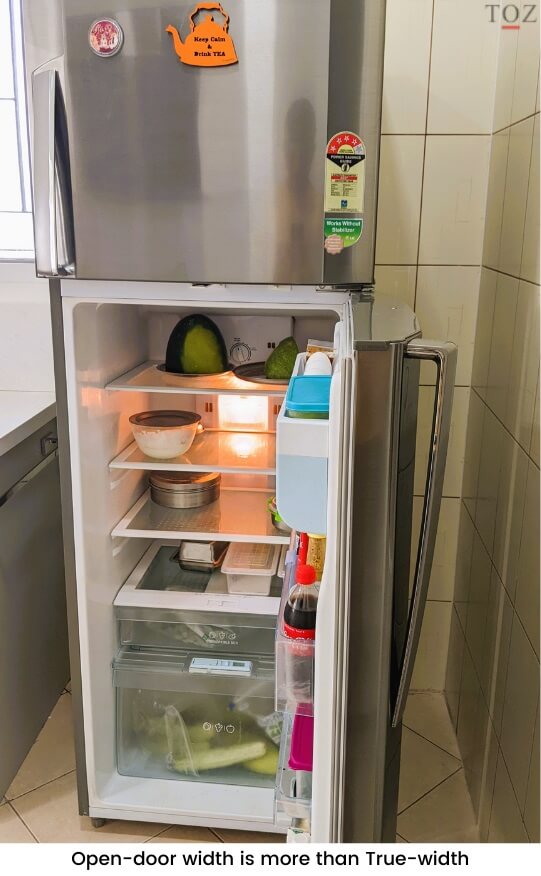
One solution to the above problem is to buy a left-handed refrigerator that’s hinged on its left side. However, in some cases, a left-handed refrigerator may not be viable – it could be due to kitchen layout or due to the refrigerator being kept inside a cabinet or enclosure that has been sized for true-width.
Another way to address the issue is to buy a refrigerator model where the true width is equal to the open-door width. For example, some models achieve this by having the lowest door-shelf very narrow, which in turn allows the vegetable basket to slide out easily even when the door is open at 90 degrees. Some models completely eliminate the lowest door shelf, which in turn allows for a larger vegetable basket.
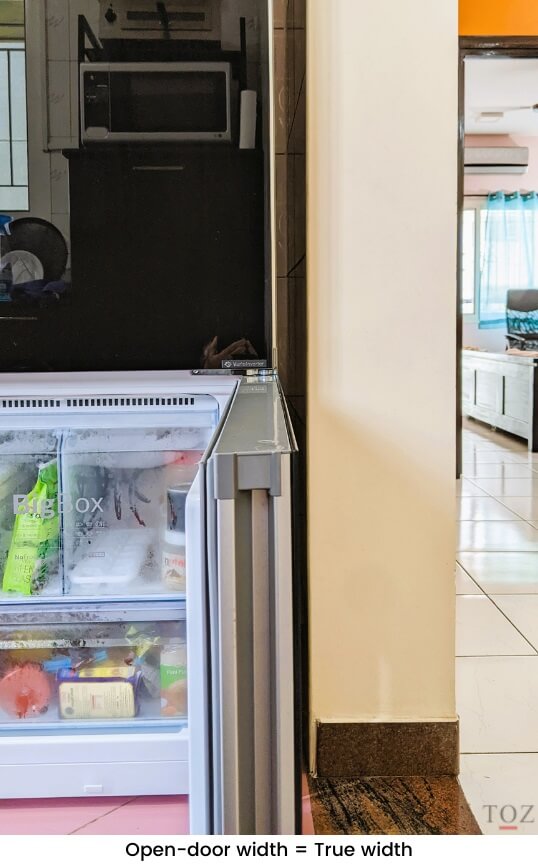
2.5 Inverter compressors
I won’t get technical into details of how compressors work, but I believe it’s important to understand some basic fundas (concepts) to help you make an informed choice.
Let’s take a quick look at the 2 types of compressors:
2.5.1 Normal compressors
These have only 2 modes of operation – on and off. When on, they run at a fixed speed and cool the refrigerator interiors. When the necessary temperature is reached, they switch off. So they keep alternating between on and off modes all through the day. Now, every time they switch on, there is a spike in current usage (though just for a moment), to get the compressor started. As refrigerators run 24×7, such spikes add up over time, leading to a considerable increase in electricity costs. Also, these refrigerators cannot run on most home inverters as the current spikes are too much for a home inverter to handle.
2.5.2 Inverter compressors
These compressors never stop running. They are essentially variable speed compressors that vary their speed depending on the cooling needs of the refrigerator. As the target temperatures comes closer, the compressor speed reduces and it cools the refrigerator slowly. Electric current spikes are avoided, and hence electricity consumption is reduced. This makes inverter compressors more energy efficient and since there are no spikes in current, they can even run on a home inverter. Refrigerators using inverter compressors generally have high energy star ratings.
As thumb rule, it’s better to buy a refrigerator with an inverter compressor. They cost more initially, but you save a lot more in the longer run.
Different brands use different software algorithms to fine-tune the functioning of the inverter compressor and give it their own fancy name (names that typically associate with intelligence, smartness and efficiency). While some algorithms will consider the weather, some will track the frequency, duration and timing of the doors being opened, and come up with how the compressor speed should vary through the day to efficiently maintain the target temperature. While such algorithms are good, they contribute more towards fine-tuning and I don’t see much of a point in paying significantly more for them.
Linear inverter compressors are relatively new, having entered the market only a few years back. These are technically more efficient than the normal inverter compressors owing to lower friction levels, but I’m not fully convinced about whether they are worth the significant premiums they are currently sold at. It would make sense to opt for them once they’re more common and the premiums drop further.
2.6 Smart refrigerators
While there is a lot of excitement around smart home devices, I still don’t see a point in buying a smart refrigerator as yet. Current smart refrigerator models seem more focussed towards the service team rather than the customer. They use a smartphone app to connect to the refrigerator and share key diagnostics of the refrigerator with the service team when you have an issue. This way, the service team can diagnose the issue better, and can send the service executive rightly equipped to solve the issue in one visit. While it is a good use of technology, I wouldn’t be willing to pay extra for it, since the refrigerator is a product that rarely needs to be serviced. A couple of high-end models of smart refrigerators have touchscreens and features like sensing food inside, voice recognition and making shopping lists, but to be frank, I really don’t see much of a point in any of these features.
2.7 Other features
While there are a lot of non-sensical features that refrigerator brands use to market their products, there are a few that can be quite useful, provided they match your lifestyle and daily habits. For instance, there are refrigerator models that come with convenient features like transparent doors and external ice-dispensing options. These reduce the need for opening the refrigerator door frequently, which in turn helps in reducing electricity costs. However, you must consider your lifestyle preferences and daily habits to see how often you would practically use these features and weigh its benefits against the premium you pay for them.
A feature might be great in itself, but it becomes useful to you only when it matches your lifestyle and daily habits, allowing you to reap its benefits.
Each brand will try to differentiate themselves with some features, some of which are nothing but marketing gimmicks. Be it about cooling the door quickly, or having a signature way of circulating air, it doesn’t really make any major difference and should definitely not be your primary criteria for selecting a refrigerator.
Personal experience:
I was once impressed by one brand that claimed that its refrigerator ensured that there was no loss of vitamins in the food kept in it. It was only later that the store manager informally told me that it was actually just a vitamin tablet they put near one of the vents in the refrigerator.
2.8 Serviceability
As a general rule, always research about the customer service level of a brand before buying their product. Make sure you check the service levels specific to your own locality by asking dealers and others living in your community, as service levels can vary significantly across cities and even areas within cities.
2.9 Warranty
Though refrigerators are known to last for years and rarely break down, it doesn’t hurt to have a look at the warranty coverage. Consider a refrigerator that comes with atleast 2yrs of warranty. The compressor is the most expensive component of the refrigerator and some brands give a separate warranty on it. In such cases, look for models where you get atleast a 10-year warranty on the compressor.
3. Conclusion
Prima facie, a refrigerator purchase may seem like a relatively simple exercise, but as we have seen above, taking some of these little aspects into consideration, can go a long way in utilising space effectively, saving money and adding convenience to your daily life.
Have questions or queries?
If you have any questions, feel free to mention it in the comments section at the end of this page; I will do my best to answer them. Please allow a few days for me to respond. If I (or any other reader) can answer it, then good. If not, atleast it will be something for the next reader to keep in mind. In case you have any learnings or experience to share, do mention it there for the benefit of other readers.
If you are looking to buy new kitchen appliances, you can refer to a few of my other posts on:
- Choosing the right chimney, hob and exhaust fan for your kitchen
- Difference between a microwave, OTG and a convection oven
- Selecting a washing machine
- Choosing the right dishwasher
In case you are planning to design your kitchen, you can refer my post on designing a kitchen that details a structured approach on how to going about it. It also takes a deeper look at design and material considerations you must keep in mind for different kitchen components like cabinets, shutters, drawers, countertop, fittings, sink and lights.
In case you are planning on doing up other parts of your house as well, you could refer to some of my other posts:
- 4 factors to consider when designing or selecting a wardrobe – this delves into factors like build material options, pros and cons of different types of shutters, designing wardrobe internals (shelves, drawers, fittings), buying readymade versus getting it custom-made.
Share this post:

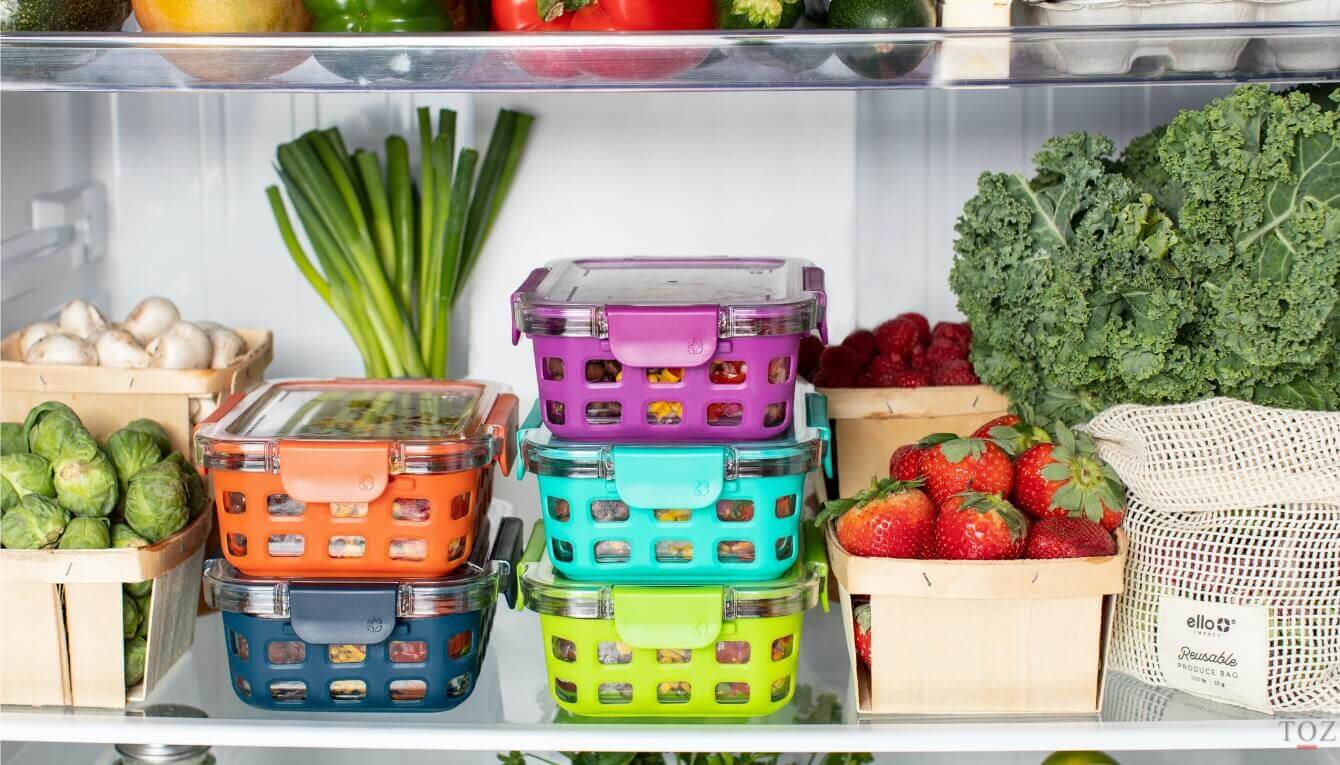
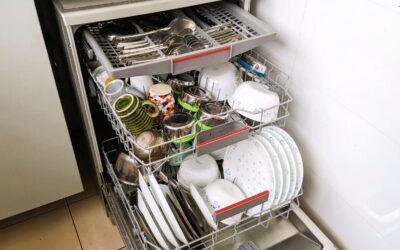
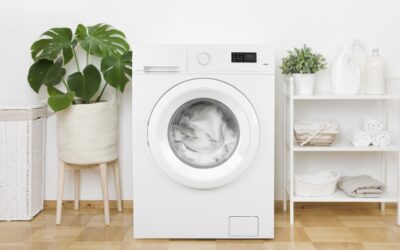


I think compressor noise should also be criteria for selection. Do advise about this .
Also thickness of the metal sheet used is also important because thin sheets get rusted within short time.
Good point, Mukund.
Yes, compressor noise should also be a criterion. I remember earlier, how we used to be able to hear the compressor even from our bedroom, especially at night. But these days, compressors have become quite silent, especially with the inverter models coming in. I didn’t notice significant sound levels when the products are new. But I guess with time, the ones with poorer quality would get louder.
The challenge of rusting is particularly acute in areas closer to the sea. A thicker metal sheet would help, but even that would eventually succumb to rust. I think an anti-rust coating would help. Unfortunately, I haven’t noticed any brands providing any such coating as yet.
Hi,
I Found your post very insight full and has very good points which all buyers needs to keep in mind while looking for new product. Infact this will help buyers Not to get lost in the Sales Pitch which is been made by the guy in the store to sell a particular feature.
Also would like to understand your views on the product which has low CO2 emission.
Thanks.
Thanks Varun.
Refrigerators using inverter compressors have lower CO2 emissions as they are far more efficient and don’t have a spike in current. The spike actually causes a more CO2 emissions at the power station.